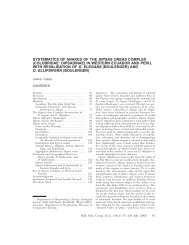cryptic species within the dendrophidion vinitor complex in middle ...
cryptic species within the dendrophidion vinitor complex in middle ...
cryptic species within the dendrophidion vinitor complex in middle ...
Create successful ePaper yourself
Turn your PDF publications into a flip-book with our unique Google optimized e-Paper software.
SPECIES IN THE DENDROPHIDION VINITOR COMPLEX N Cadle 211<br />
Figure 13. Comparison of closely size-matched males of (A, C) Dendrophidion crybelum (LACM 148590, 625 mm SVL) and (B,<br />
D) D. apharocybe (LACM 148601, 653 mm SVL). (A) and (B) are to <strong>the</strong> same scale, (C) and (D) to <strong>the</strong> same scale. Relative to<br />
body size, Dendrophidion crybelum has a more robust body and a broader head than D. apharocybe.<br />
venter without extensive dark pigment,<br />
usually only scattered spots on <strong>the</strong> most<br />
posterior ventrals (venter often heavily<br />
marked with dark pigment, especially posteriorly);<br />
smaller body size (adults commonly<br />
more than 1 m <strong>in</strong> total length); a shorter<br />
relative tail length <strong>in</strong> adults, ,60% of SVL<br />
(tail usually more than 60% of SVL); and <strong>in</strong><br />
hemipenial morphology (hemipenes bulbous<br />
ra<strong>the</strong>r than long and cyl<strong>in</strong>drical; a<br />
sp<strong>in</strong>ose battery followed distally by several<br />
transverse flounce-like structures). In D.<br />
dendrophis and D. nuchale auctorum <strong>the</strong><br />
anal plate may be ei<strong>the</strong>r s<strong>in</strong>gle (as <strong>in</strong> D.<br />
crybelum) or divided.<br />
Dendrophidion crybelum differs from D.<br />
apharocybe and D. <strong>v<strong>in</strong>itor</strong> most notably <strong>in</strong><br />
hemipenial morphology, <strong>in</strong>clud<strong>in</strong>g overall<br />
shape (elongate and cyl<strong>in</strong>drical vs. shorter<br />
and bulbous <strong>in</strong> <strong>the</strong> last two <strong>species</strong>),<br />
number of sp<strong>in</strong>es (.70 vs. ,45), and apical<br />
morphology (narrow and with reduced<br />
calycular structures vs. nude and strongly<br />
<strong>in</strong>cl<strong>in</strong>ed <strong>in</strong> D. apharocybe, or with well<br />
developed membranous ridges and an apical<br />
boss <strong>in</strong> D. <strong>v<strong>in</strong>itor</strong>). See complete descriptions<br />
for details.<br />
O<strong>the</strong>r characteristics dist<strong>in</strong>guish<strong>in</strong>g D.<br />
crybelum from D. apharocybe and D.<br />
<strong>v<strong>in</strong>itor</strong> are subtle. Dendrophidion crybelum<br />
is a more robust animal than ei<strong>the</strong>r D.<br />
apharocybe or D. <strong>v<strong>in</strong>itor</strong>, which is most<br />
easily seen <strong>in</strong> side-by-side comparisons of<br />
<strong>in</strong>dividuals of comparable body length, as<br />
shown for two males illustrated at <strong>the</strong> same<br />
scale <strong>in</strong> Figure 13. The body of D. crybelum<br />
is more massive, and <strong>the</strong> head is larger and<br />
more angular, than similar sized specimens<br />
of D. apharocybe or D. <strong>v<strong>in</strong>itor</strong>.<br />
Adults of D. crybelum have f<strong>in</strong>e dark<br />
speckl<strong>in</strong>g on <strong>the</strong> subcaudal scales, often<br />
concentrated along suture l<strong>in</strong>es, and small<br />
dark flecks and spots on <strong>the</strong> posterior ventral<br />
plates (Fig. 14). However, <strong>the</strong>se features<br />
vary among adults (very dist<strong>in</strong>ct and numerous<br />
to only scattered flecks), and <strong>the</strong>y appear<br />
to develop ontogenetically. Juveniles often<br />
have only a f<strong>in</strong>e pepper<strong>in</strong>g on <strong>the</strong> distal<br />
subcaudals form<strong>in</strong>g a dark suffusion easily<br />
visible only with magnification. On <strong>the</strong> o<strong>the</strong>r<br />
hand, apart from lateral dark pigment on <strong>the</strong><br />
ventrals and subcaudals common to all<br />
<strong>species</strong> of Dendrophidion, <strong>the</strong> ventral plates<br />
and subcaudals of D. apharocybe and D.<br />
<strong>v<strong>in</strong>itor</strong> are immaculate (Fig. 14; see Fig. 6<br />
for D. <strong>v<strong>in</strong>itor</strong>). Dendrophidion crybelum<br />
averages fewer pale bands on <strong>the</strong> body than<br />
D. apharocybe or D. <strong>v<strong>in</strong>itor</strong> (Table 1; p ,<br />
0.01 and p , 0.001, respectively), although<br />
<strong>the</strong> ranges overlap greatly. The pale neck<br />
bands <strong>in</strong> D. crybelum are typically broader<br />
than those of D. <strong>v<strong>in</strong>itor</strong> (Fig. 2).<br />
Description (8 males, 8 females). Table 1<br />
presents standard meristic and mensural<br />
Bullet<strong>in</strong> of <strong>the</strong> Museum of Comparative Zoology harv-160-04-01.3d 11/4/12 19:59:20 211







